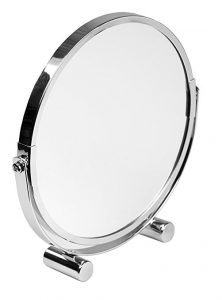If you have just bought a high end, or even budget spinning top, then you’re probably in need of a spin base (also known as a spin station). The engineering that goes into a precision top is so astounding that it would be a real waste to lose that magnificence by spinning on something substandard.
Just like the tops themselves, spin bases come in many shapes and sizes, and perhaps more importantly prices. There are three main categories of spin bases; concave mirrors, concave lenses, and specialist spin bases. Though any concave (curving inwards) surface will do, the harder and more durable the surface is, the better quality and duration of spin you are going to get.
Spin bases
Spin-Things Spin Base
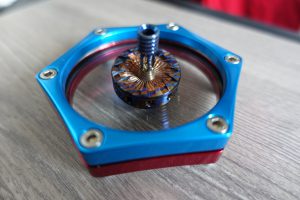 The Spin-Things spin base is the first product made by spin things. it consists of a watch glass lens secured between two aluminium holders. The whole base is then held together with six nautical grade bolts. All of this combines to make an incredibly rugged and reliable spin base.
The Spin-Things spin base is the first product made by spin things. it consists of a watch glass lens secured between two aluminium holders. The whole base is then held together with six nautical grade bolts. All of this combines to make an incredibly rugged and reliable spin base.
The benefit to having a base like the spin-things base is that you can take it with you with little to no protection. Other models of base need to be included in a case, or wrapping. However the spin-things base can be thrown into a bag or even pocket with no issues.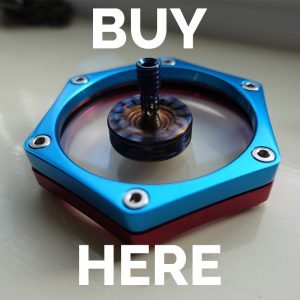
You likely won’t be breaking your spin time records with this model of base, but the versatility more than makes up for that!
Buy your Spin-Things base here for $30 (£22.49).
Cosmetic mirror
This is by far the cheapest option of spin base. Most cosmetic mirrors have some sort of “zoom” on them. That zoom is created by being concave. These cheap mirrors are usually a concave glass surface over some reflective material, sometimes silver. However, because of their widespread use for other things, they are extremely cheap, but offer a hard to beat service. After the mirror option, the improvements are minimal, so you only need look further than a mirror if you are really concerned about spin quality and duration.
The second benefit to using a mirror is that it allows you to see the underside of your top as it spins. On a lens or specialist spin base, this is not visible. Therefore, a lot of people with lenses will also put a mirror underneath for the same effect. What’s more is that most mirrors come with housing. This means that they will sit readily on a table, something that can’t be said for all lenses.
The downsides to using a mirror are that the untreated glass is not made to have metal things spun or dropped onto it. This means that they can be easily damaged and after a while your top can spin in a chip or mark, and this will create flutter. However, at the price they are, it’s relatively easy to simply buy another.
Buy Here US | UK | Canada
Concave lens
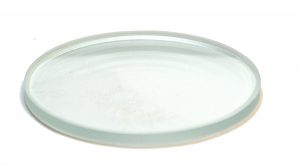 Lenses are the one step up from a cosmetic mirror, but are substantially harder to get your hands on, especially if you live outside of the US. A lens offers a marginally tougher surface than a mirror, but is generally used for the more sleek and professional look. It is also possible to get a lens with a greater or lesser slope (focal length, as these are usually manufactured as looking glasses or piano tuners).
Lenses are the one step up from a cosmetic mirror, but are substantially harder to get your hands on, especially if you live outside of the US. A lens offers a marginally tougher surface than a mirror, but is generally used for the more sleek and professional look. It is also possible to get a lens with a greater or lesser slope (focal length, as these are usually manufactured as looking glasses or piano tuners).
Generally lenses come in smaller sizes which means that they are for the more experienced and confident spinner. And, as most don’t have sides for someone that doesn’t mind the risk of the top running off on a bad launch. The smaller sizes are however a plus point for a lot of users, especially those that want a sleeker display and don’t like the look of a large unsightly mirror.
As lenses generally either come as single concave (the other side therefore being convex) one would need some sort of stand to house the lens, and this can pose another financial burden. Although, double concave lenses are available.
Buy Here US | UK | Canada
Specialist spin Bases
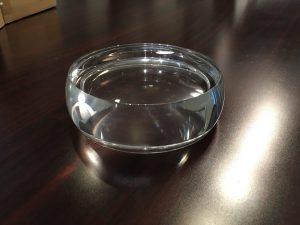 This is where things get interesting (and expensive) these spin bases are generally made by the makers of tops. They are made with hardened glass that can in some cases be stronger than metal. This means that your top is very unlikely to damage the surface of the station (in fact it could be the other way around), and you will be able to count on the base for a reliable spin time and quality.
This is where things get interesting (and expensive) these spin bases are generally made by the makers of tops. They are made with hardened glass that can in some cases be stronger than metal. This means that your top is very unlikely to damage the surface of the station (in fact it could be the other way around), and you will be able to count on the base for a reliable spin time and quality.
However, with the bespoke nature of spin bases, comes an inherent cost. Most specialist spin bases will set you back more than $100 and can range to far in excess of that depending on the brand and design.
below are some options for buying, but there are many more makers out there of great products, like Billetspin, DB Flameworks, and Spin Docs

